Tommy Wisdom
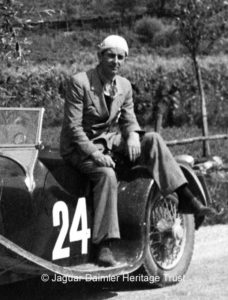
1936 Tommy Wisdom
SS100 Jaguar BWK 77
Born in 1906 in Brighton, Thomas Henry (Tommy) Wisdom was a motoring correspondent for the Daily Herald and a racing driver who specialised in endurance events, entering 52 sports car races in 33 years, including 23 Monte Carlo rallies. Out of the 12 Le Mans 24 Hours races he entered, Wisdom won twice – in 1950 and 1952, and of the 10 Mille Miglia races he was a class winner in 1949, 1952 and 1957.
Early Racing
He started racing in 1931 entering the RAC Tourist Trophy in an Invicta which he shared with J Chilton, Donald Healey and Dudley Froy, finishing 19th.
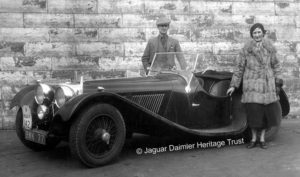
1936 Tommy and ‘Bill’ Wisdom
Racing ran in the family, his wife Elsie, known as ‘Bill’, was also a racing driver and their daughter Ann competed in international rallies, most notably as Pat Moss’ co-driver, one of the most successful female auto rally drivers of all time.
Wisdom raced a variety of marques including: Singer, Riley, MG, Jaguar, Aston Martin, Bristol, Nash-Healey, Austin-Healey, Jowett and Bentley, and among his co-drivers were Jack Fairman, Leslie Johnson, and Graham Whitehead, Peter Whitehead’s half-brother. His first Le Mans 24 Hour Race was in 1934 driving a Singer Nine for Singer and his first Mille Miglia in 1937 driving an MG SA with ‘Bill’ although they failed to finish.
He raced a number of Jaguars: a 1936 SS100, a 1949 XK120 and a C-type under either his own name or racing for Jaguar Cars and by letting a very young Stirling Moss race his XK120 at Dundrod in 1950, it is true to say that Wisdom really helped kick Stirling Moss’s career up a gear or two.
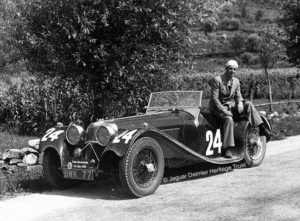
1936 Tommy Wisdom
SS100 Jaguar BWK 77
Wisdom’s first ‘Jaguar’ outing was in 1936, when together with ‘Bill’, they won a “Coupes des Glaciers” in the International Alpine Trials in a 2.7 litre Jaguar SS 100, registered BWK 77. Coventry proprietor and SS distributor S.H. (Sam) Newsome had helped persuade William Lyons to let him run. This proved the Jaguar SS 100 was fast, reasonably controllable on loose surfaces and could handle quick altitude changes and was the start of his association with what SS / Jaguar Cars.
At the September 1938 meeting at Brooklands, Lyons asked Wisdom what he thought about an engineer called Walter Hassan. Although he had never met Hassan, Lyons had heard his name mentioned over the years as one of the best in the business. SS Cars was developing fast and Chief Engineer William Heynes needed an assistant to take some of the workload. Wisdom gave Hassan an excellent reference during the conversation with Lyons and the result was that the two men met and Lyons offered he a job at Foleshill. Hassan joined SS Cars later that year as Chief Experimental Engineer and, at first, worked on tuning the SS 100 engines for racing.
Jaguar’s pre-production XK120 (chassis 660001) registered as HKV 500, won first time out at Silverstone in 30th August 1949 driven by Leslie Johnson. Following that race, Hassan and Wisdom took the XK120 on a continental test run in order to determine what further development work was needed and to assess the car’s chances on the Alpine Rally. In Switzerland conditions were difficult and visibility was reduced by a snow storm. Hassan recalled, “The climb was abandoned at about 6,500 ft and the descent began. Times were taken over the sections which were climbed in reasonable conditions, and Mr Wisdom expressed the opinion that the car had a fair amount in hand over the average speed required. He also remarked on the stability under acceleration in lower gears enabling full throttle to be used without tail slides”.
After Jaguar’s success at Silverstone in 1949 the company prepared five cars for 1950 for: Clemente Biondetti, Leslie Johnson, Peter Walker, Wisdom and motor trader, Nick Haines. All but Walker took part in the 1950 Mille Miglia in April, with Johnson finishing 5th . The other two finished 8th and 16th with Wisdom failing to finish. Wisdom took his XK120 to 3rd place in the Circuito de Porto race in June behind an Alfa Romeo and Osca-Maserati special. That year he drove a Jowett Jupiter at Le Mans, with Tommy Wise, finishing 16th. His last outing in a Jaguar in 1950 was at Silverstone on 26th August finishing 7th in the XK120.
Two cars were entered in his name for the RAC Tourist Trophy at Dundrod in September 1950. Wisdom drove the Jowett Jupiter himself and lent his Jaguar XK120 to Stirling Moss, agreeing to split any prize money. Moss scored his first major international race victory, setting a new circuit record and winning £140 before handing Wisdom his cut.
Moss recalled. “When 1950 came along, John Heath had already signed me up to drive for HWM, but I was going too fast for my experience. I was very inexperienced. No one would give me a car. I tried MG, Jaguar and others. It was my age and lack of experience that held me back. The Dundrod RAC Tourist Trophy (TT) was the classic race and I wanted to take part. Then Tommy Wisdom came to the rescue. He had a Jowett and asked me if I would like to borrow his XK120, which were like hen’s teeth then, but he told me that we could share the car fifty-fifty. It was fantastic.”
Wisdom’s recollections about the Tourist Trophy race some years later: “I was taking high octane refreshment in the Sterling Wheel Club, London’s mecca of motor sporting folk, when a fresh-faced, curly-haired youngster whom I already knew slightly, Stirling Moss by name, came alongside, drew up a bar stool and dropped a broad hint. He’d noticed that I’d filed two entries for the forthcoming Tourist Trophy… what were my plans for whichever car I didn’t drive myself? An hour later I found I’d accepted, subject to his father’s OK, the persuasive Stirling’s proposition that he should drive my XK in the TT, leaving me to handle the works-owned Jowett Jupiter that its makers had entered. Moss had never driven an XK120 when our TT pact was made, but the makers sportingly put one at his disposal for pre-Dundrod familiarization drives on the road. I say sportingly because I think they were beginning to kick themselves for not having offered the boy a TT drive themselves. They had turned Moss down as too young and inexperienced”.
Moss recalled, “I was very grateful to Tommy Wisdom for fixing it up so that I could borrow his car. Sir William came up to me that evening and asked if I would lead the team the following year”.
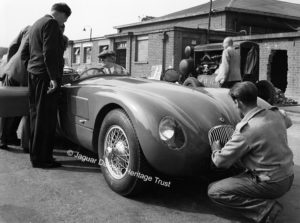
1952 Tommy Wisdom collecting
C-type XKC005 from Browns Lane
Wisdom was involved in disc brake research with his XK120 and later wrote, “…old friend Joe Wright of Dunlop asked me whether I proposed to press on with the disc brake experimental and development work. I agreed readily and we all got busy…” Referring to Moss’s victory at the 1952 Reims GP sports car race, driving Wisdom’s and Cannell’s second production car, “I think it can fairly be claimed that the modern disc brake, as fitted to millions of regular passenger cars, owes something to the pioneer work of Moss and my small team in those far off days”.
Wisdom bought the 5th C-type built (chassis XKC005), with Bill Cannell of Moores, Jaguar’s Brighton distributors. He collected this from the factory on 26th May 1952, registered MDU 212, and raced it only once, in the Monaco grand Prix on 2nd June 1952. He drove it all the way there, raced – finishing 6th, becoming the first private owner to finish a race in a C-type, then drove it all the way back home again. He lent the car to the works team for use in the disc brake development programme and it was fitted with experimental Dunlop disc brakes and a gearbox operated Plessey pump. On 29th June 1952, Moss drove it to victory at the Reims Grand Prix. The first race win for a car equipped with disc brakes!
For the 1953 Mille Miglia, Wisdom lent his C-type (XKC005) to Tony Rolt to share with newly-recruited mechanic Len Hayden, but after maintaining a good average speed, a big end seized near Pescara.
Race results – Jaguar Related
|
Year |
Date |
Race |
Result |
Car / Co-driver |
Entrant / Team |
| 1934 | 17 June | Le Mans 24 Hours (His first Le Mans) |
DNF | Singer Nine Le Mans with John Donald Barnes |
Singer |
| 1936 | 20-27 August | International Alpine Trial | 1st | SS 100 Jaguar with ‘Bill’ Wisdom |
SS Cars Ltd |
| 1937 | 4 April | Mille Miglia, Italy | DNF | MG SA with ‘Bill’ Wisdom |
|
| 1950 | 23 April | Mille Miglia, Italy | DNF | Jaguar XK120 with Anthony Hume |
Jaguar Cars |
| 18 June | Circuito do Porto, Portugal | 3rd | Jaguar XK120 | ||
| 26 August | Silverstone International |
7th | Jaguar XK120 | Tom Wisdom | |
| 1951 | 5 May | Silverstone International |
9th | Jaguar XK120 | T H Wisdom |
| 17 June | Circuito do Porto, Portugal Portuguese Grand Prix |
DNF | Jaguar XK120 | ||
| 15 September | Dundrod, Northern Ireland RAC Tourist Trophy |
1st | Jaguar C-type (XKC005) driven by Stirling Moss | T H Wisdom | |
| 1952 | 2 June | Monaco Grand Prix |
6th | Jaguar C-type | T H Wisdom |
| 1953 | 14 May | Sicily Targa Florio |
17th | Jaguar C-type | Jaguar Cars |
Life After Jaguars
In 1953 Wisdom began a very successful association with Bristol Cars and Jack Fairman, resulting in an 8th and a 12th place in 1954, and a 9th in 1955.
He raced for Donald Healey from 1956 participating in two Mille Miglias and two Targa Florios. In 1959 he was one of the BMC team of three drivers breaking records at Bonneville Salt Flats driving EX219. This car started life in 1954 as the MG EX179 driven to 153.69 mph by George Eyston and Ken Miles, and was then used in a number of other record breaking runs. In 1959 it was re-badged as the Austin-Healey EX219 in honour of the new Sprite and with a supercharged 948 cc engine achieved various long distance Class G records at speeds up to 147 mph.
EX219 now resides at the British Motor Museum at Gaydon.
On February 1962 Wisdom wrote an article for The Motor, with the title, “GRAND TOURING – Expedition by E-type”.
In the article he wrote, “The Wisdom Winter Expedition to the Swiss Lakes, provided a chance to discover how that superb example of the car maker’s art – the Jaguar E-type coupe – performed under Grand Touring conditions”.
His wife “Bill”, daughter Ann and her boyfriend and fellow works rally driver Peter Riley accompanied him on his winter challenge, each sampled the E-type coupe from the Geneva launch, 9600 HP.
Wisdom’s account of the winter expedition:
“Mrs W., despite fond memories of stark Rileys and MG Magnettes at Brooklands, is nowadays only interested in high performance cars so long as their speed is achieved in comfort and silence. On our winter run to Switzerland the journey south-east through France was naturally over main roads – my favourite short cuts are inadvisable in the winter and, in any case, traffic is relatively light. Including stops for petrol and the frontier crossing, the Jaguar averaged 49½ mph to Montreux and this was dawdling, for we were changing drivers to give everyone the opportunity of sampling the E-type under winter conditions. The journey back was made under more pressure. The same route was followed from Montreux round the lake to Lausanne, to Vallorbe, and by way of Pontarlier, Chaumont, Chalon-sur-Saone, Reims and Arras to Dunkirk. The last 100 miles being in that wet mist so typical of northern France. Our best hour was just after St Dizier to Reims – 71 miles. The overall average was 60.3. This involved frequent cruising at 100 mph and three times the speedometer needle exceeded 120 mph. But I could not rid myself of the recurring thought – the racing Jaguar 3 ½ -litre SS100 at Brooklands before the war was not as fast as this. (Then we managed a lap at 118 mph).
The round trip of 1,378 miles was covered at an average petrol consumption of 21.2 mpg. We were impressed by the easy pace of the Jaguar, its quietness and comfort; in the favourite phrase of the motor testers, it fairly eats up the miles.
The car was as steady as a rock at three-figure speeds; the pronounced camber of some of the northern routes nationales had no effect on the steering wheel. It is at these touring speeds that the driver must keep alert; there is no physical effort required. On the open road, with its 20 mph to maximum in top gear, there is no need to change gear in the Jaguar – and therefore the mind must be attuned to the possible emergency.
“Here is a car which, like a pedigree gun or a green-heart trout rod, is so worth learning to use properly”.
‘Bill’ Wisdom died on 13th April 1972.
Tommy Wisdom died later the same year, on 12th November, at the age of 66, in Birmingham.
SS100 Jaguar BWK 77
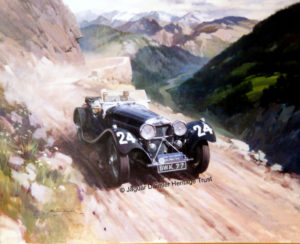
Oil Painting of BWK 77
by Michael Turner 1986
Wisdom’s exploits in the 1936 International Alpine Trials in his SS100 BWK 77 are immortalised in oils, painted by Michael Turner in 1986, mounted on the wall in the Collections Centre at the British Motor Museum at Gaydon.
BWK 77 had an engine upgrade to 3.5 litre in 1937 and won a race at Brooklands at 118 mph. By 1939 it had been upgraded sufficiently to lap at 125 mph and continued to be raced after WWII in the hands of a number of owners including George Matthews and David Barber, right through to the mid 1990s.
BWK 77 still survives. Known as ‘Old Number 8’ it was kept at the Moray Motor Museum at Elgin, Moray, Scotland for 25 years and raced every year including Goodwood, Silverstone, Donington, Oulton Park, Snetterton, Castle Coombe, Rockingham, Croft and Knockhill in Scotland. It has been hill-climbed at Shelsley Walsh and Bowness and has had a very quick dash up the test hill at Brooklands. In 2020 it changed hands and is now owned by JB Racing and was at the Jaguar Etype60 celebrations at Shelsley Walsh on the weekend of 12-13 June 2021.
It is still in excellent condition although the original engine has been safely set aside and is now running with a supercharged engine delivering 260 bhp, making it extremely fast. To help deliver all this power to the tarmac it runs with twin rear tyres.
C-Type XKC005 – MDU 212
C-type XKC005 went on to have a very busy and successful racing career, notching up numerous firsts in the hands of: Michael Head; Rosemary Vickers; John Barber; David Lewis, W Smith, H A Pierpoint and D head.
The car was displayed in Tom Wheatcroft’s museum in Donington for some years and has since appeared at a number of Goodwood Revival meetings.
It was rebuilt in 2010 and then re-united with Sir Stirling Moss and his co-driver, Norman Dewis, at the 2012 Mille Miglia. Just as they did in 1952, Moss and Dewis started the 2012 Mille Miglia from beside, rather than on, the start ramp – as Moss was concerned about the danger of grounding out the C-type. Then with the aid of a police escort they completed a parade lap around Brescia.
Authors: Shihanki Elpitiya and Tony Merrygold
Race results from www.RacingSportsCars.com
© Text and Images – Jaguar Daimler Heritage Trust
Sources and Further Reading:
-
Parker, Chas and Porter, Philip, Jaguar C-Type: The Autobiography of XKC 051 (Porter Press International Ltd, 2017)
-
Grimsdale, Peter, High Performance: When Britain Ruled the Roads (Simon & Schuster UK, 2020)
-
Mennem, Patrick, Jaguar: An Illustrated History (The Crowood Press Ltd, 1991)
-
Whyte, Andrew, Jaguar: The Definitive History of a Great British Car (Patrick Stephens Limited, 1990)
-
Porter, Philip, Jaguar: E-Type The Definitive History (Porter Press International, 2015)
-
Berry, Robert, Jaguar: Motor Racing and the Manufacturer (Distributed by E.P. Dutton, 1978)
-
Porter, Philip, Jaguar: Sports Racing Cars (Bay View Books, 1995)
-
Clausager, Anders Ditlev, Le Mans (Littlehampton Book Services Ltd, 1982)
-
Skilleter, Paul, Norman Dewis of Jaguar: Developing the Legend (PJ Publishing Ltd, 2017)
-
Porter, Philip and Skilleter, Paul, Sir William Lyons: The Official Biography (Haynes Publishing, 2001)
-
Edwards, Robert, Stirling Moss: The Authorised Biography (Cassell & Company, 2001)
-
Porter, Philip, Stirling Moss: The Definitive Biography – Volume 1 (Porter Press International, 2016)
-
Porter, Philip, The Most Famous Car in the World: The Story of the First E-type Jaguar (Cassell, 2000)